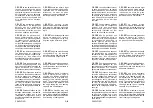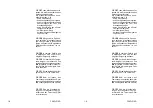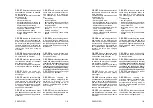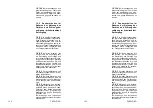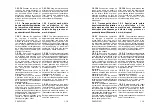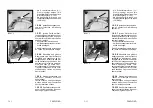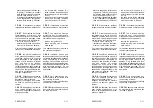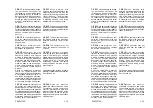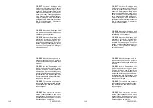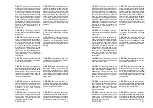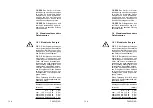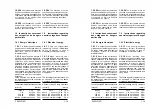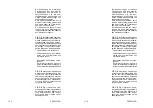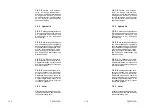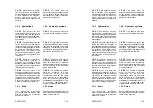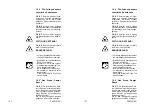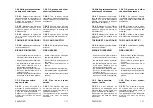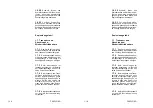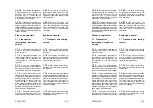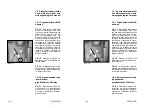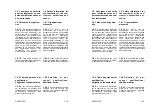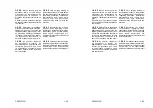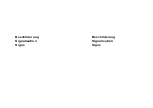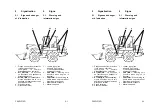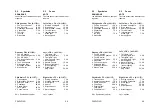
F08D/F10D
F08D/F10D
1-15
1-15
Lors de rapprochement à des lignes
électriques aériennes, tous les
mouvements de travail de la
machine doivent être prises en
considération comme p.ex. les
positions de la flèche, le mouve-
ment pendulaire de cordes et les
dimensions de charges élinguées.
Egalement des inégalités de terrain,
par lesquelles la machine est mise
en position inclinée, doivent être
pris en considération. En présence
de vent, des lignes électriques
aériennes et de même des installa-
tions de travail peuvent osciller et
donc réduire la distance.
1.6.1.3
En cas de transfert
électrique, le conducteur doit lever,
abaisser ou pivoter les installations
de travail ou sortir la machine, resp.
balayer l’installation de travail hors
de la zone de danger. Ceci n’étant
pas possible,
- ne pas quitter la place du con-
ducteur
- prévenir les personnes qui se
trouvent à proximité de ne pas
s’approcher de la machine et de
ne pas la toucher
- faire couper la tension
- ne quitter la machine avant
d’être sûr que la ligne ayant été
touchée/endommagée est sans
courant!
1.6.1.4
Des travaux sur des
installations ou moyens d’exploita-
tion électrique ne peuvent être
effectués que par un électricien
compétent ou par des personnes
initiées sous la direction et
surveillance d’un électricien
compétent et selon les règles
électrotechniques.
1.6.1.5
L’équipement électrique
d’une machine doit être contrôlé et
inspecté régulièrement. Des dé-
fauts constatés tels que raccorde-
ments desserrés ou câbles
carbonisés doivent être éliminés
immédiatement.
Lors de rapprochement à des lignes
électriques aériennes, tous les
mouvements de travail de la
machine doivent être prises en
considération comme p.ex. les
positions de la flèche, le mouve-
ment pendulaire de cordes et les
dimensions de charges élinguées.
Egalement des inégalités de terrain,
par lesquelles la machine est mise
en position inclinée, doivent être
pris en considération. En présence
de vent, des lignes électriques
aériennes et de même des installa-
tions de travail peuvent osciller et
donc réduire la distance.
1.6.1.3
En cas de transfert
électrique, le conducteur doit lever,
abaisser ou pivoter les installations
de travail ou sortir la machine, resp.
balayer l’installation de travail hors
de la zone de danger. Ceci n’étant
pas possible,
- ne pas quitter la place du con-
ducteur
- prévenir les personnes qui se
trouvent à proximité de ne pas
s’approcher de la machine et de
ne pas la toucher
- faire couper la tension
- ne quitter la machine avant
d’être sûr que la ligne ayant été
touchée/endommagée est sans
courant!
1.6.1.4
Des travaux sur des
installations ou moyens d’exploita-
tion électrique ne peuvent être
effectués que par un électricien
compétent ou par des personnes
initiées sous la direction et
surveillance d’un électricien
compétent et selon les règles
électrotechniques.
1.6.1.5
L’équipement électrique
d’une machine doit être contrôlé et
inspecté régulièrement. Des dé-
fauts constatés tels que raccorde-
ments desserrés ou câbles
carbonisés doivent être éliminés
immédiatement.
When approaching overhead lines
all working movements of the
machine must be taken into
consideration, e.g. the position of
jibs, the swinging of ropes and the
dimensions of slung loads.
In addition, attention must be paid
to any roughness of soil which could
cause an inclined position of the
machine thus getting it closer to the
overhead line. The fact that
overhead lines may swing out
during windy weather and may
reduce the distance must also be
taken into consideration.
1.6.1.3
In the case of sparking
over any work or movement must
stop. Instructions to be followed:
bring the machine out of the danger
area by lifting or lowering the
attachments or by swiveling away
or driving the machine out of the
area. If this is not possible then the
following rules must be observed:
- do not leave the driver’s cabin
- warn persons standing near the
machine not to approach or touch
the machine
- give immediate instructions to
have the power cut off
- leave the machine only when it is
sure that the electricity in the da-
maged/contacted power line is
switched off so that the line is dead!
1.6.1.4
Work on the electrical
system or on the operating system
may only be carried out by a skilled
electrician or by personnel
instructed or supervised by such
trained electrician according to
electrotechnical regulations.
1.6.1.5
The electrical installation
of a machine must be reviewed/
inspected at regular intervals. Any
defects, e.g. loose connections or
scorched cabling, must be
eliminated immediately.
When approaching overhead lines
all working movements of the
machine must be taken into
consideration, e.g. the position of
jibs, the swinging of ropes and the
dimensions of slung loads.
In addition, attention must be paid
to any roughness of soil which could
cause an inclined position of the
machine thus getting it closer to the
overhead line. The fact that
overhead lines may swing out
during windy weather and may
reduce the distance must also be
taken into consideration.
1.6.1.3
In the case of sparking
over any work or movement must
stop. Instructions to be followed:
bring the machine out of the danger
area by lifting or lowering the
attachments or by swiveling away
or driving the machine out of the
area. If this is not possible then the
following rules must be observed:
- do not leave the driver’s cabin
- warn persons standing near the
machine not to approach or touch
the machine
- give immediate instructions to
have the power cut off
- leave the machine only when it is
sure that the electricity in the da-
maged/contacted power line is
switched off so that the line is dead!
1.6.1.4
Work on the electrical
system or on the operating system
may only be carried out by a skilled
electrician or by personnel
instructed or supervised by such
trained electrician according to
electrotechnical regulations.
1.6.1.5
The electrical installation
of a machine must be reviewed/
inspected at regular intervals. Any
defects, e.g. loose connections or
scorched cabling, must be
eliminated immediately.
Summary of Contents for AF 100
Page 61: ...F08D F10D F08D F10D Beschilderung Beschilderung Signalisation Signalisation Signs Signs ...
Page 76: ...F08D F10D F08D F10D 2 8 2 8 Schriftzug Lärmarme Baumaschine Schriftzug Lärmarme Baumaschine ...
Page 104: ...F08D F10D F08D F10D Beschreibung Beschreibung Description Description Description Description ...
Page 177: ...F08D F10D F08D F10D Wartung Wartung Entretien Entretien Maintenance Maintenance ...
Page 219: ...F08D F10D F08D F10D Störung Ursache und Abhilfe Störung Ursache und Abhilfe ...
Page 222: ...F08D F10D F08D F10D Dérangements causes et remèdes Dérangements causes et remèdes ...
Page 225: ...F08D F10D F08D F10D Malfunctions causes and remedies Malfunctions causes and remedies ...
Page 228: ...Anhang Anhang Appendice Appendice Appendices Appendices ...
Page 229: ......
Page 230: ......
Page 237: ......
Page 242: ...F08D F10D F08D F10D A 10 3 A 10 3 ...
Page 243: ...F08D F10D F08D F10D B 10 3 B 10 3 ...
Page 244: ...F08D F10D F08D F10D C 10 3 C 10 3 ...
Page 245: ...F08D F10D F08D F10D D 10 3 D 10 3 ...
Page 246: ...F08D F10D F08D F10D E 10 3 E 10 3 ...
Page 247: ...F08D F10D F08D F10D F 10 3 F 10 3 ...

